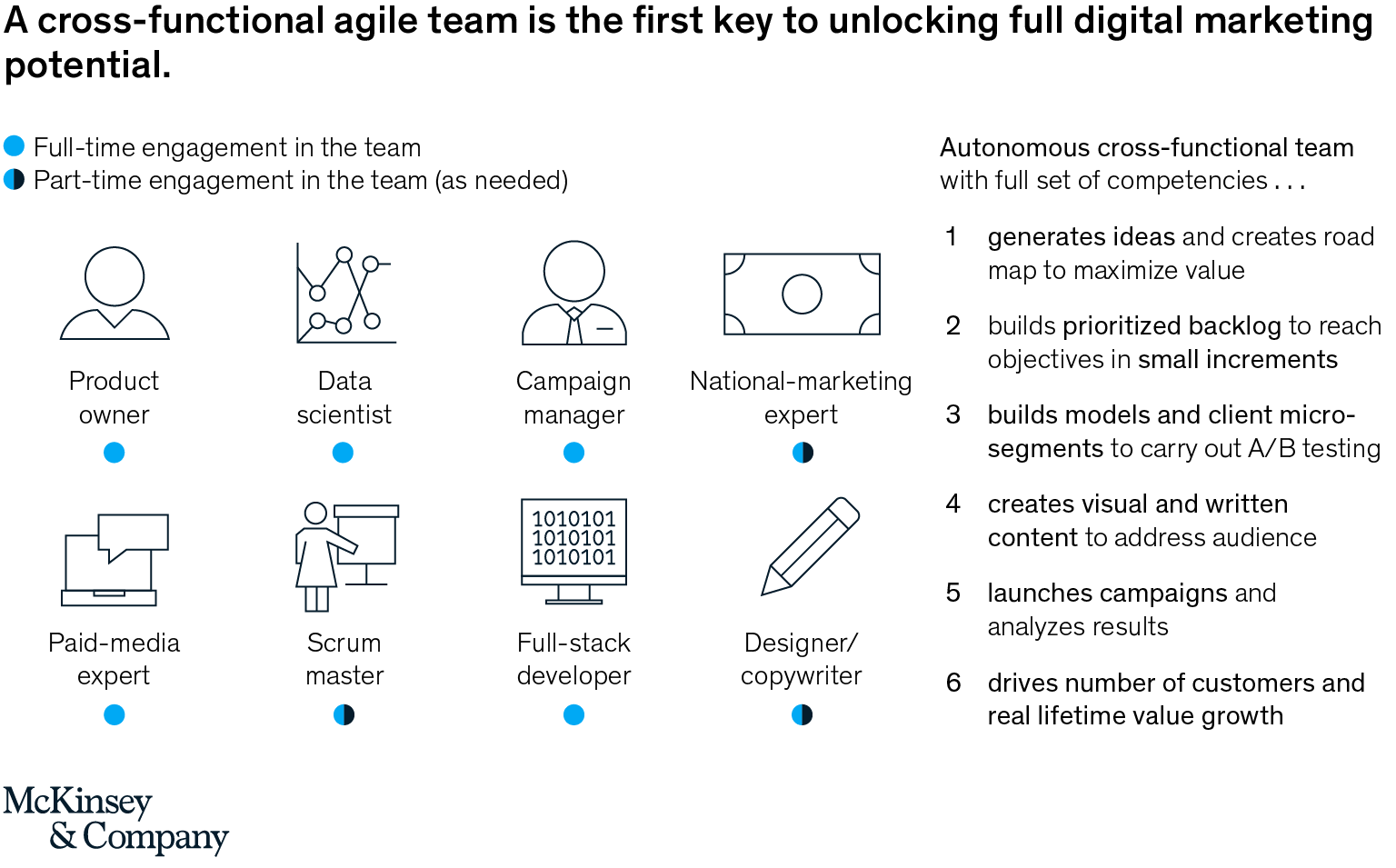Relying on agencies and aggregators to manage your digital spend may trade competitive advantage for convenience. Companies like KFC are taking a different approach.]
Key takeaways
- Digital marketing today provides an unprecedented level of insight into consumers.
- Many companies fail to take advantage of this granularity, falling back on agencies and aggregators to manage their digital-marketing investments.
- A more hands-on approach can rapidly drive double-digit revenue growth—without increasing marketing budgets.
For a long time, companies flew blind: marketers had little data to measure the impact of their spending on traditional media, such as TV and print advertising, on specific target audiences. Digital marketing has changed all that: today, most companies have granular performance data, down to the level of individual customers. The problem? If you’re relying on agencies and aggregators to manage your media investments, you may have gone from flying blind to flying on autopilot.
When everyone is taking this approach, it’s tough to stand out, and the need to be more strategic about how and where you spend will only increase as privacy regulations impose higher restrictions on access to customer data. That’s why it’s time to consider deactivating the autopilot. Maximizing the impact of your spend may require taking the helm and adopting a data-driven, test-and-learn regimen. Some pioneers of this approach achieve double-digit revenue growth without increasing their budgets, often within the span of only a few months.
Here we lay out the potential benefits of a more hands-on approach to digital, explain the benefits of a test-and-learn approach, and explore how KFC, one of the world’s largest restaurant chains, with more than 23,000 locations, targeted five actions to drive better performance from its digital-marketing efforts. It’s time to grab the controls.
The problem: Autopilot digital marketing
Digital marketing is booming. Irrespective of industry and geography, companies are allocating a growing share of marketing budgets to digital channels. In fact, over the course of the past four years, all growth in global advertising has come from digital advertising as spending on traditional channels has fallen (Exhibit 1).

This should be good news. Unlike the megaphone marketing approach of print media and television, digital media bring a wealth of data about the impact of investments, down to the level of the reaction of individual customers to minor changes in a campaign or process—for example, the difference made by adding an emoji to a push notification or removing a step from the checkout process. For the first time in marketing history, decision makers can access granular performance data to transform the customer experience and maximize impact all along the consumer journey.
The bad news is most marketers don’t yet take full advantage of this opportunity. Instead of setting concrete targets and using the most effective performance metrics to systematically optimize their digital-marketing investments, they entrust their budgets to agencies and aggregators. If they track return on investment (ROI) at all, it’s top-level ROI only. The net result is typically average performance at best.
Consider a company that relied on autoselecting the geography of its target customers. The problem? One of its biggest buying groups was commuters, who should have been actively targeted away from home. Marketing dollars were spent by another company on engaging an agency to run its text-messaging efforts, using the company’s own database of mobile-phone numbers. After so-so results, the company decided to check the list: around 25 percent of the numbers were inactive. The agency had no incentive to check the list for errors, as its compensation was based on call volume, regardless of whether or not the numbers were active. Had the company not been on autopilot, it might have identified the problem.
Privacy regulation is also making digital marketing more challenging as it changes how companies can gain insight into the behavior of individual consumers, a phenomenon sometimes described as the “sunset of cookies,” the small text files used to identify users online. As a result, companies are working on protecting the privacy of individual users through more contextual approaches and joining up marketing and sales functions to better use first-party information from consenting customers.
There’s no denying the appeal of running digital-marketing efforts on autopilot—exercising more control is resource intensive and often inconvenient. But the effort required should be weighed against the potential improvement in digital-marketing performance and ROI. After all, in our text-message example, taking a more active approach to managing activity didn’t just result in identifying a quarter of mobile numbers that were inactive; it saved 25 percent of the cost of those push-marketing efforts. Just small, incremental improvements across a host of marketing efforts can add up, providing true competitive advantage in exchange for the loss in convenience.
A potential solution: Plotting a course to better performance
Making the most of the opportunities afforded by digital marketing requires leaders to deactivate the autopilot and assume full control of their investments. Although it isn’t a simple switch, best-practice companies adopt a systematic, data-driven, test-and-learn approach within and across channels. They understand there’s no such thing as a “steady state” or “business as usual” in the digital age, and it may not always make sense to draw up or stick rigidly to annual plans for digital marketing. Instead, they adopt a regimen of high-frequency testing and learning across core channels: paid media, customer-relationship management, user experience and user interface, and third-party fulfillment (for example, delivery and channel partners). They measure the impact of each activity along the customer journey and refine investment tactics accordingly.
For example, one UK company moved from the standard approach of bidding on Google AdWords based on cost per action to bidding based on maximizing margin (self-calculated and imported). This change alone saved it £15 million, in part because the algorithm was able to target gateway products, resulting in more sales. Similarly, one retailer found that simply changing the order of items in its mobile application—specifically, moving high-value items to the top of the list—led to a 5 percent increase in sales. Similar opportunities to boost sales with data-driven optimization exist in e-commerce.
Such testing and learning can help yield quick wins, such as increasing the customer conversion rate by making minor tweaks to the execution of an ad, and reduce the risk in making major changes, such as large budget allocation shifts from, for example, new-customer acquisition via search ads to remarketing via personalized campaigns. Data-driven testing and learning can also be a gift that keeps on giving. Over time, the marketing mix becomes more tailored to a company’s specific situation, objectives, and target groups—and the sooner a company adopts systematic testing and learning, the harder it becomes for competitors to catch up.
Switching to manual control
Deactivating the autopilot may sound simple, but there are more challenges than may be anticipated. Success relies on an organizational commitment to change, maintaining discipline in tying investments to customer responses, and continuously acting on the feedback loop (see sidebar, “A look at KFC’s growth-hacking program”).
What you want is the ability to react more swiftly and flexibly to changes in customer preferences as shown in Exhibit 2, competitor moves, the media landscape, and overall market dynamics. Marketers should be able to channel funds to priorities and tactics proven to work and to avoid spending money on things that don’t. Pioneers of this approach have created impact in the magnitude of 5 to 10 percent in annual same-store growth.

Sustaining the positive impact of turning off the digital autopilot requires building the capabilities necessary to ensure you can remain in control. Leading companies typically take three steps:
- Find a captain. You need a leader in the organization willing to be a pioneer—to take the risk of implementing the new way of working and demonstrate positive ROI and team engagement. In some cases, companies have a hard time deviating from their customary hands-off approach and may bring in external experts as catalysts of change. The right person or taskforce will promote a more hands-on approach, inject performance-marketing expertise, convey agile best practices, put in place the appropriate tools, and build new habits in the digital marketing team.
- Build the plane. You can’t fly without an engine or instruments. While you don’t always need the latest technology, flying without autopilot is easier if you can automate bidding, launch, data transfer, and collection. Good pilots often start from the plane they have and look for a combination of home-grown, open-source, and commercial options.
- Train the crew. The rapid growth of performance marketing means there is often a greater demand for roles than the existing talent can fill, making learning on the job crucial for team members transitioning from other parts of the organization. This is why leading companies ensure team members see the power of the new hands-on approach in real-life settings and empower them to build momentum sprint by sprint.
As continuous testing and learning is established in digital marketing, data-driven decision making and agile practices can be applied to offline elements of the marketing mix, such as point-of-sale materials and store layout. New technologies such as sensors, pattern-recognition software, and smart shopping carts can help enable retailers to optimize in-store activities with the same rigor they apply to digital marketing. That way, visibility should increase and data-driven agile marketing will chart the path for other disciplines.
Marketing is a differentiating capability for many consumer-facing businesses. Learning to fly solo can also be a source of differentiation: it doesn’t mean abandoning proven tools, but it may make it possible to fly higher and take on what KFC calls “heart-led leadership.”
…
This article first appeared in www.mckinsey.com
Seeking to build and grow your brand using the force of consumer insight, strategic foresight, creative disruption and technology prowess? Talk to us at +971 50 6254340 or mail: engage@groupisd.com or visit www.groupisd.com/story




